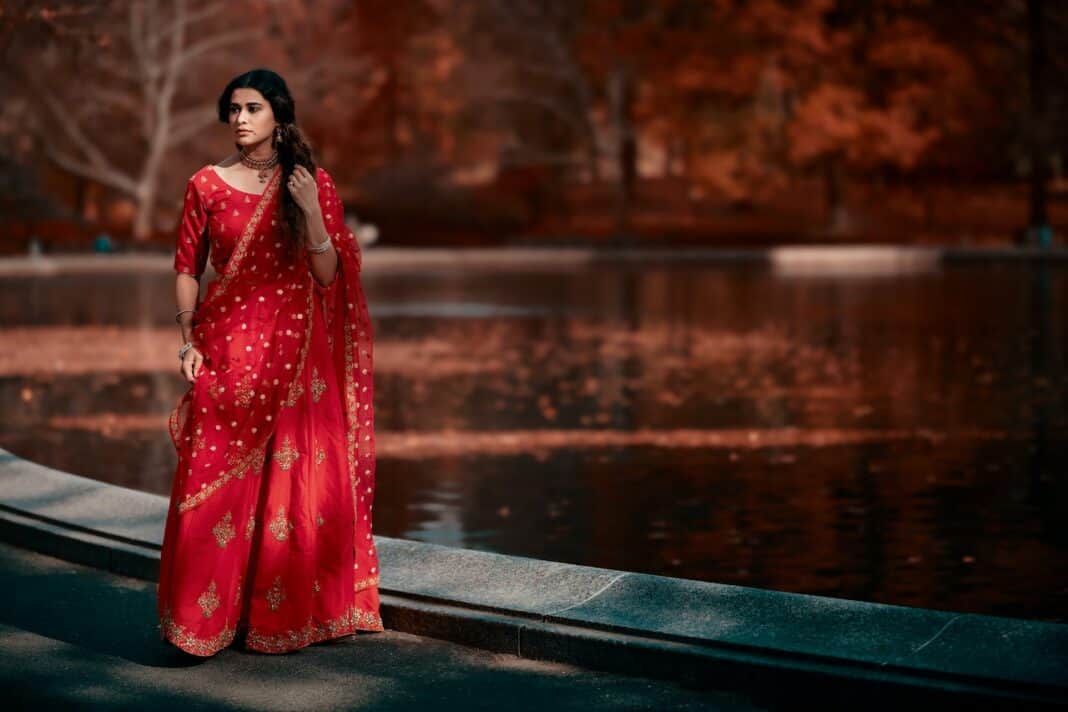Sarees are a timeless traditional garment in India, loved by women of all ages. They are versatile and come in various styles, designs, and materials, each with a unique charm. This article will focus on three types of sarees – Organza Half Sarees, New Organza Sarees, and Traditional Silk Saris. Whether you’re a saree enthusiast or new to sarees, this guide will help you learn more about these beautiful garments and choose the perfect one.
Organza Half Sarees:
Organza half sarees are the latest trend in the world of sarees. They are a fusion of the traditional saree and the stylish lehenga, making them the perfect choice for women who want to look stylish and elegant. An organza half saree is draped like a traditional saree but with a pre-stitched lehenga attached to the bottom half. It makes it much easier to wear and adds a touch of glamour to the traditional saree.
- Advantages of Organza Half Sarees
One of the most significant advantages of organza half sarees is that they are incredibly comfortable to wear. Unlike traditional sarees, which can be challenging to manage and can require several hours of practice to get right, organza half sarees are much easier to wear and maintain. They also provide a lot more freedom of movement, making them perfect for women who want to attend a wedding or a special occasion but don’t want to be restricted by a traditional saree.
Another advantage of organza half sarees is that they are versatile and can be dressed up or down depending on the occasion. You can opt for a heavily embroidered organza half saree for a formal event, complete with glittering jewelry and high heels. For a more casual look, you can choose a simple, pastel-colored organza half saree paired with flat sandals and minimal jewelry.
- How to Choose the Perfect Organza Half Saree
When choosing an organza half saree, there are several factors you need to consider. Firstly, consider the occasion and your style. Choose a heavily embellished organza half saree with intricate embroidery for a wedding. In contrast, a simple, solid-colored organza half saree would be more appropriate for a more casual event.
Another essential factor to consider is the color. Organza half sarees come in various colors, from pastel shades to bright, bold hues. Choose a color that compliments your skin tone and enhances your overall look.
Finally, consider the design and embellishments. Organza half sarees come in various formats, from heavily embroidered to simple, minimalist styles. Choose a plan that fits your style and makes you feel comfortable and confident.
New Organza Sarees:
- What are New Organza Sarees?
New organza saree is the latest addition to the world of sarees. They are made from lightweight, transparent material, giving them a unique, delicate look. The fabric is typically adorned with intricate embellishments, such as embroidery, sequins, or beadwork, making each new organza saree unique.
- Advantages of New Organza Sarees
One of the most significant advantages of new organza sarees is that they are very lightweight and comfortable. Unlike traditional silk sarees, which can be heavy, new organza sarees are incredible.
Traditional silk saree
The traditional silk sari is a timeless garment worn by women in India for centuries. It symbolizes elegance, grace, and femininity and continues to be a popular choice for special occasions, festivals, and traditional celebrations. In this article, we’ll take a closer look at the conventional silk sari and what makes it such a unique garment.
- What is a Traditional Silk Sari?
A traditional silk sari is a rectangular piece of cloth typically six to nine yards long and between one and two yards wide. The fabric is usually made from silk, although other materials, such as cotton or chiffon, may be used. To wear a traditional silk sari, the fabric is first wrapped around the waist and then draped over one shoulder, leaving the other shoulder exposed. The end of the material is then tucked into the waistband, creating a simple and elegant look.
- History
The traditional silk sari has a long and rich history in India and is believed to have been worn by women for thousands of years. During the Indus Valley Civilization, women wore a simple sari made from a single cloth.
- The Art of Wearing a Saree
Wearing a traditional silk sari requires some skill and practice. The sari must be wrapped and draped to stay in place and not slip while allowing for freedom of movement. The traditional way of wearing a sari involves several complex folds and tucks, and it can take years of practice to master the art of wearing a sari. However, the result is beautiful and elegant.
- The Different Kinds of Traditional Silk
There are many styles of traditional silk sari, each with its unique look and personality. Some of the most popular types include the Nivi, the most commonly worn sari style in India; the Kaccha Nivi, a more relaxed style; and the Maharashtrian Sari, which is typically worn in the western region of India.
- Choosing the Perfect One
When choosing a traditional silk sari, there are several factors to consider. Firstly, consider the occasion. Choose a sari with intricate embellishments and elaborate designs for a wedding or a special celebration. A simple, solid-colored sari would be more appropriate for a more casual event.
Another essential factor to consider is the color. Traditional silk saris come in various colors, from pastel shades to bright, bold hues. Choose a color that compliments your skin tone and enhances your overall look.
Finally, consider the material. Traditional silk sarees can be made from various materials, including silk, cotton, and chiffon. Choose a material that is comfortable to wear and suits the occasion.
In conclusion, organza half sarees, new organza sarees, and traditional silk sarees offer a range of options for women who want to embrace traditional Indian fashion in their own unique way.














